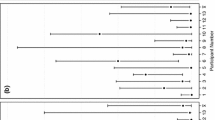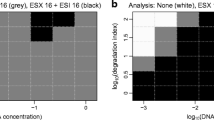Abstract
How can the forensic scientist rationally justify performing a sequence of tests and analyses in a particular case? When is it worth performing a test or analysis on an item? Currently, there is a large void in logical frameworks for making rational decisions in forensic science. The aim of this paper is to fill this void by presenting a step-by-step guide on how to apply Bayesian decision theory to routine decision problems encountered by forensic scientists on performing or not performing a particular laboratory test or analysis. A decision-theoretic framework, composed of actions, states of nature, and utilities, models this problem, and an influence diagram translates its notions into a probabilistic graphical network. Within this framework, the expected value of information (EVOI) for the submission of an item to a particular test or analysis addresses the above questions. The development of a classical case example on whether to perform presumptive tests for blood before submitting the item for a DNA analysis illustrates the use of this model for source level questions in forensic biology (i.e., questions that ask whether a crime stain consisting of a particular body fluid comes from a particular person). We show how to construct an influence diagram for this example, and how sensitivity analyses lead to an optimal analytical sequence. The key idea is to show that such a Bayesian decisional approach provides a coherent framework for justifying the optimal analytical sequence for a particular case in forensic science.







Similar content being viewed by others
Data availability
Not applicable.
Code availability
Not applicable.
Notes
As opposed to whom the DNA comes from, because there could be background DNA unrelated to the assault on the surface of the bloodstain(s).
We use the word "coherent" following Lindley (1985), p. 22:
(...) it will not be possible to say that a decision is right but only that these decisions cohere, or not. It is the relationships between events or decisions that matter, not the individual events or decisions.
Hence, a normative framework provides constraints that ensure coherence in decision making. These constraints demand that the decision maker’s degrees of belief in uncertain events, as well as his or her degrees of satisfaction with the choices’ possible consequences, obey the laws of probability.
The list is exhaustive when the decision maker inevitably chooses one of the actions in the list. Note that if it is possible for the decision maker to do nothing, then this possibility must be defined as one of the actions for the action space to be exhaustive.
The actions are mutually exclusive if the decision maker can never choose more than one of them at one time.
A discussion on the role of subjective probabilities and their relation with frequencies is introduced in Taroni et al. (2018).
A gamble between two outcomes means that one of them will occur with a probability p and the other with a probability \((1-p)\).
Note that the forensic scientist here is interested specifically in obtaining the DNA profile of a bloodstain, and is not interested in the DNA profile of any other biological material of human origin that may be present on the surface on which the stain was recovered.
We purposely did not specify a monetary unit, as these costs will vary from lab to lab and from country to country, and these numbers are for illustrative purposes only.
The literature also commonly uses the terms sensitivity and specificity, which are \(1-\beta\) and \(1-\alpha\), respectively.
For example, was a gorilla present on the crime scene? Or, more realistically, what is the probability that the surface on which the trace was recovered was freshly cleaned with a bleach solution?
These extremes represent perfect information which attain the maximum utility values for performing a DNA analysis (i.e., \(u(O_{11})\)) and for not performing a DNA analysis (i.e., \(u(O_{2-})\)).
References
Berger JO (2010) Statistical decision theory and Bayesian analysis, 2nd edn. Springer-Verlag, New York
Biedermann A, Bozza S, Taroni F (2008) Decision theoretic properties of forensic identification: underlying logic and argumentative implications. Forensic Sci Int 177:120–132
Biedermann A, Bozza S, Garbolino P, Taroni F (2012) Decision-theoretic analysis of forensic sampling criteria using Bayesian decision networks. Forensic Sci Int 223:217–227
Biedermann A, Bozza S, Taroni F, Vuille J (2020) Computational normative decision support structures of forensic interpretation in the legal process. SCRIPTed: a Journal of Law. Technol Soc 17:83–124
Bozza S, Broseus J, Esseiva P, Taroni F (2014) Bayesian classification criterion for forensic multivariate data. Forensic Sci Int 244:295–301
Butler J, Chaseling J, Wright K (2019) A comparison of four presumptive tests for the detection of blood on dark materials. J Forensic Sci 64:1838–1843
Castello A, Francès F, Verdu F (2017) Bloodstains on leather: examination of false negatives in presumptive test and human hemoglobin test. J Forensic Sci 62:1308–13133
Cook R, Evett IW, Jackson G, Jones PJ, Lambert JA (1998) A hierarchy of propositions: deciding which level to address in casework. Sci Just 38:231–240
de Finetti B (1939) The theory of probability in its relationships with the analysis. In: Monari P, Cocchi D (eds) (1993) Probabilità e induzione. Editrice Clueb, Bologna, pp 365–374
Edwards W (1988) Summing up: The society of Bayesian trial lawyers. In: Tillers P, Green ED (eds) Probability and inference in the law of evidence: The uses and limits of Bayesianism. Kluwer Academic Publishers, Dordrecht, pp 337–342
Gittelson S, Biedermann A, Bozza S, Taroni F (2012) The database search problem: a question of rational decision making. Forensic Sci Int 222:186–199
Gittelson S, Bozza S, Biedermann A, Taroni F (2013) Decision-theoretic reflections on processing a fingermark. Forensic Sci Int 226:e42–e47
Gittelson S (2013) Evolving from inferences to decisions in forensic science. Dissertation, University of Lausanne
Gittelson S, Biedermann A, Bozza S, Taroni F (2014) Decision analysis for the genotype designation in low-template-DNA profiles. Forensic Sci Int Genet 9:118–133
Gittelson S, Steffen CR, Coble MD (2016) Low-template DNA: a single DNA analysis or two replicates? Forensic Sci Int 264:139–145
Gittelson S, Steffen CR, Coble MD (2016) Expected net gain data of low-template DNA analyses. Data Brief 8:375–386
Gomes C, Lopez-Matayoshi C, Palomo-Diez S, López-Parra AM, Cuesta-Alvaro P, Baeza-Richer C, Gibaja JF, Arroyo-Pardo E (2017) Presumptive tests: a substitute for benzidine in blood samples recognition. Forensic Sci Int Genet 6:e546–e548
De Groot MH (1970) Optimal statistical decisions. Wiley, Hoboken
Hochmeister MN, Budowle B, Sparkes R, Rudin O, Gehrig C, Thali M, Schmidt L, Cordier A, Dirnhofer R (1999) Validation studies of an immunochromatographic 1-step test for the forensic identification of human blood. J Forensic Sci 44:597–602
Jensen FV, Nielsen TD (2007) Bayesian networks and decision graphs, 2nd edn. Springer, New York
Johnston E, Ames CE, Dagnall KE, Foster J, Daniel BE (2008) Comparison of presumptive blood test kits including Hexagon OBTI. J Forensic Sci 53:687–689
Kahneman D, Tversky A (1984) Choices, values and frames. Am Psychol 39:341–350
Kaplan J (1968) Decision theory and the factfinding process. Stanford Law Rev 20:1065–1092
Kaye DH (1988) Introduction: What is Bayesianism? In: Tillers P, Green ED (eds) Probability and inference in the law of evidence: the uses and limits of Bayesianism. Kluwer Academic Publishers, Dordrecht, pp 1–19
Kaye DH (1999) Clarifying the burden of persuasion: what Bayesian decision rules do and do not do. Int J Evid Proof 3:1–29
Kjaerulff UB, Madsen AL (2008) Bayesian networks and influence diagrams: a guide to construction and analysis. Springer, New York
Korb KB, Nicholson AE (2011) Bayesian artificial intelligence, 2nd edn. CRC Press, Boca Raton
Krawczak M, Schmidtke JO (1992) The decision theory of paternity disputes: optimization considerations applied to multilocus DNA fingerprinting. J Forensic Sci 37:1525–1533
Lindley DV (1985) Making decisions, 2nd edn. Wiley, Chichester
Lindley DV (2000) The philosophy of statistics. Statist 49:293–337
Lindley DV (2006) Understanding uncertainty. Wiley, Hoboken
Nease RF, Owens DK (1997) Use of influence diagrams to structure medical decisions. Med Decis Making 17:263–276
Owens DK, Shachter RD, Nease RF (1997) Representation and analysis of medical decision problems with influence diagrams. Med Decis Making 17:241–262
Phillips VL, Saks MJ, Peterson JL (2001) The application of signal detection theory to decision-making in forensic science. J Forensic Sci 46:294–308
Piva de Almeida J, Glesse N, Bonorino C (2011) Effect of presumptive tests reagents on human blood confirmatory tests and DNA analysis using real time polymerase chain reaction. Forensic Sci Int 206:58–61
Raiffa H, Schlaifer R (1961) Applied statistical decision theory. The M.I.T Press, Cambridge
Raiffa H (1968) Decision analysis—introductory lectures on choices under uncertainty. Addison-Wesley, Reading
Savage LJ (1951) Theory of statistical decision. J Am Stat Assoc 46:55–67
Savage LJ (1972) The foundations of statistics, 2nd edn. Dover, New York
Shachter RD (1986) Evaluating influence diagrams. Oper Res 34:871–882
Sironi E, Gittelson S, Bozza S, Taroni F (2021) Minor or adult? Introducing decision analysis in forensic age estimation. Sci Justice 61:47–60
Taroni F, Bozza S, Aitken CGG (2005) Decision analysis in forensic science. J Forensic Sci 50:894–905
Taroni F, Bozza S, Bernard M, Champod C (2007) Value of DNA tests: a decision perspective. J Forensic Sci 52:31–39
Taroni F, Bozza S, Biedermann A, Garbolino G, Aitken CGG (2010) Data analysis in forensic science: a Bayesian decision perspective. Wiley, Chichester
Taroni F, Biedermann A, Bozza S, Garbolino P, Aitken CGG (2014) Bayesian networks for probabilistic inference and decision analysis in forensic science. John Wiley & Sons, Chichester
Taroni F, Garbolino P, Biedermann A, Aitken CGG, Bozza S (2018) Reconciliation of subjective probabilities and frequencies in forensic science. Law Prob Risk 17:243–262
Taroni F, Garbolino P, Bozza S (2020) Coherently updating degrees of beliefs: Radical probabilism, the generalization of Bayes’ theorem and their consequences on evidence evaluation. Law Prob Risk 19:293–316
Taylor D, Abarno D, Hicks T, Champod C (2016) Evaluating forensic biology results given source level propositions. Forensic Sci Int Genet 21:54–67
Tillmar AO, Mostad P (2014) Choosing supplementary markers in forensic casework. Forensic Sci Int Genet 13:128–133
Tobe SS, Watson N, Daéid NN (2007) Evaluation of six presumptive tests for blood, their specificity, sensitivity, and effect on high molecular-weight DNA. J Forensic Sci 52:102–109
von Neumann J, Morgenstern O (1947) The theory of games and economic behavior, 2nd edn. Princeton University Press, Princeton
Funding
This research was funded by the Swiss National Science Foundation grant numbers 100014-135340 and 100011 204554/1.
Author information
Authors and Affiliations
Contributions
Conceptualization: FT; Methodology: SG; Formal analysis and investigation: SG; Writing—original draft preparation: SG; Writing—review and editing: SG and FT; Funding acquisition: FT.
Corresponding author
Ethics declarations
Conflict of interest
The authors declare no conflict of interest. The funders had no role in the design of the study; in the collection, analyses, or interpretation of data; in the writing of the manuscript; or in the decision to publish the results.
Ethical approval
Not applicable.
Consent to participate
Not applicable.
Consent for publication
Not applicable.
Additional information
Publisher's Note
Springer Nature remains neutral with regard to jurisdictional claims in published maps and institutional affiliations.
Rights and permissions
Springer Nature or its licensor (e.g. a society or other partner) holds exclusive rights to this article under a publishing agreement with the author(s) or other rightsholder(s); author self-archiving of the accepted manuscript version of this article is solely governed by the terms of such publishing agreement and applicable law.
About this article
Cite this article
Gittelson, S., Taroni, F. To test or not to test? A question of rational decision making in forensic biology. Artif Intell Law (2024). https://doi.org/10.1007/s10506-023-09386-3
Accepted:
Published:
DOI: https://doi.org/10.1007/s10506-023-09386-3




